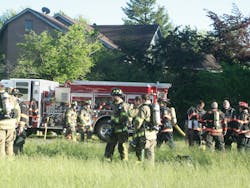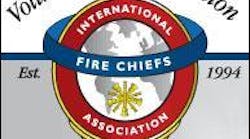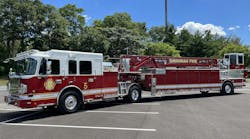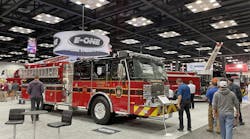Whenever we get a new person into the firehouse, we welcome them with open arms. We clothe them, we get to know them and their families, and vice versa. Most important of all we teach them our tactics and nuances as a department. We show them our standard operating guidelines (SOGs), teach them “our way” and show them how to use our apparatus.
We consider it giving our new firefighter the best training to carry on the way our department does things. If that member stays around, we consider it a great investment, and then someone else new shows up and we do it all over again. Now this in-house training is to improve and enhance our firefighters, and remind them on how we do things, but what about showing others how we do things?
We all have mutual aid companies, both in the career and volunteer service, and that mutual aid comes from our neighbors. Now rivalries aside, there usually is a little bit of bravado about which company’s tactics are better, who is more effective or who gets more firefighters at a scene. Instead of just catching a fire they run, or being at their hall for one drill, put aside the feelings and invite them over the border to train with your department. We spend large volumes of time training our own firefighters to become efficient at the tasks we need done on the fireground, why not spend time with our mutual aid companies so we can become familiar with their operations, and they with ours?
Developing a Communications Plan
Communications with our mutual aid partners is a must for a quality fire operation. Once the companies have developed a rapport with each other, mutual aid events may run a bit more smoothly, as we can have an idea of our duties once arriving on scene. Communications also are helpful to know who your mutual aid companies are.
Several years ago, on Christmas Eve, there was a large fire in an apartment complex three jurisdictions away. We were sent over to fill-in at a fire hall on the second-alarm assignment, much to all of our surprise. The company we went to cover had never notified us that we were on their mutual aid response. We went and filled the hall, but were very surprised when our fire dispatch said they were aware of the changes, but hadn’t notified us of this.
While this wasn’t a major problem or concern, we noted the assignment and went back to our fire dispatch and asked for the complete list of companies we are assigned automatically to, or where we might be sent on a second or third alarm. Many times departments send out emails to their mutual aid companies to communicate changes with standard operating guidelines (SOGs) or response preferences.
There are also other ways of communicating with other departments, but make sure that the communication occurs, so that there can be an open dialogue between the companies, and more importantly so they are aware you may call if they are needed.
Understanding Individual Operations
Now that it is known who is coming mutual aid, what do we really know about their operation, other than their running order or their command system? For some departments they are aware of how their neighbors work due to high call volume, or the setup of the running order due to town demands. For some companies though, to some extent their mutual aid is a little bit of a mystery in regards to SOGs and how their apparatus are laid out. From here, departments should start to branch out and better learn about their neighbors.
How many of us know the SOGs of our mutual aid departments; do they run a truck first then an engine to a fire, or do they respond with two engines or an engine and a truck? Many times we hear apparatus respond to an incident, but we don’t actually know why they respond in the order they are in unless we’ve talked to a member from that company. Many times we can guess pretty accurately what their operation is, but when you are running mutual aid, are you willing to chance a guess? A quick conversation with a member about apparatus placement at a scene will solve many issues and answer many questions.
Do we know how they respond to fire tactically, and what kind of manpower response can they get, are they only able to get one or two trucks out, or can you expect the whole fleet to arrive on location? How many people will be on the rigs, some departments only require a driver in apparatus in order for it to leave, so is there going to be several pieces of apparatus, but only a handful of interior firefighters? Tactically speaking, do their methods change from day time response to an evening or night time response, are they more inclined to use a defensive operation, or will they attempt an interior attack?
Training Together To Build a Rapport
The best way to answer many of these questions is to periodically invite your mutual aid companies to drill together. Lay out your trucks, open the compartments, discuss the SOGs. Swap members and send a few officers to your mutual companies and have several come into your station. Have some of your senior, more experienced officers in the department lead the instruction and send the newer officers out to the different houses so they can get an idea of what other companies do.
Take your apparatus operators off to the side and have them work with apparatus operators of other companies and get an overview of how the engines and truck work. How often are you going mutual aid with another company with the same exact make and model of apparatus as yours? Very infrequently, since even large paid departments can have different apparatus from company to company, especially in regards to their ladder trucks.
A night during the spring or summer would be a good time to have apparatus operators meet and discuss how their apparatus operates. The general principle of how specific fire apparatus works is the same across the board (engines pump water, trucks bring a big ladder and elevation, rescues bring specialized equipment, etc.). However, the way that they function, where equipment is stored and how to make them work, differs from each individual design and maker, and in some cases mutual aid apparatus may be from decades earlier, creating an issue of how it works in regards to operations. Make sure operators learn essential functions of the specific units, and also make sure they are taught any quirks the vehicles have (sometimes you need to press a button twice, or delay an extra second, or open one valve first to compensate for pressure from another).
These small items can help build that bond of firefighting. New firefighter meet and greets make things a little more personal, and makes the mutual aid departments feel more human than an abstract idea. On top of the bonding, incident operations can run more smoothly if all the working parts have a better understanding of one another. Incoming mutual aid companies can pre-plan their attack coordination better with your operation if they have an idea of what to expect of their orders prior to arrival. This can prove vital at an incident when mutual aid is called in, saving a life or a building.
SEAN WILKINSON is a captain and drill instructor with the Snyder Fire Department in Amherst, NY. He is a police dispatcher for the Town of Amherst Police and is the manager of an Urgent Care Center. He has a Bachelors of Arts in History from the University at Buffalo, and is currently completing the requirements for his Masters in Secondary Education at the University at Buffalo.







